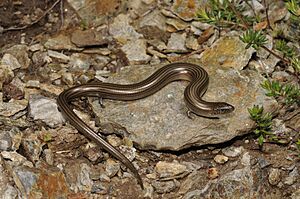Western three-toed skink facts for kids
Quick facts for kids Western three-toed skink |
|
|---|---|
 |
|
| Conservation status | |
| Scientific classification | |
| Genus: |
Chalcides
|
| Species: |
striatus
|
The western three-toed skink (Chalcides striatus) is a type of lizard that has very tiny legs. It belongs to the Scincidae family, which includes many kinds of skinks. You can find this skink in places like the Iberian Peninsula (Spain and Portugal), southern France, and parts of northwestern Italy.
This skink likes to live in many different natural places. These include temperate forests, areas with lots of shrubland, Mediterranean-style bushy areas, temperate grassland, sandy shores, arable land (farmland), pastures, and even gardens in the countryside. A French scientist named Georges Cuvier first described this animal in 1829. Its scientific name, Chalcides striatus, comes from Greek and Latin words. "Chalcides" means 'copper', and "striatus" means 'streak', probably because of its streaky look.
Contents
What Does It Look Like?
This skink might look a bit like a snake at first glance, but it's actually a lizard! The big difference is that it has two pairs of very small legs, each with three tiny toes. It has a small head and a thick neck. This skink can grow to be about 43 centimeters (about 17 inches) long.
Its skin is smooth and shiny, often a silvery or bronze color. You'll notice about ten thin, dark lines running along its body from head to tail. The head is usually a bit darker than the rest of its body. It's similar to the Italian three-toed skink, but the western three-toed skink has slightly bigger legs, and all three toes on its back feet are the same length.
Where Does It Live?
The western three-toed skink makes its home in the southwestern parts of Europe. Its range includes a small area in northwestern Italy called Liguria, southern France, Spain, and Portugal. It doesn't seem to live in eastern Spain, and there's a separate group of them living near Bordeaux in southwestern France.
These skinks can live in places up to 1,800 meters (about 5,900 feet) above sea level. They prefer damp but sunny spots with thick, low plants. You might find them in meadows, along stream banks, in marshes, on grassy slopes, and in hedges. Closer to the Atlantic Ocean, in the western part of their range, they can also live in drier areas with low bushes and gorse plants.
How It Lives
The western three-toed skink can move slowly using its tiny legs. But it can also move much faster by wiggling its body from side to side, just like a snake! When winter comes, it goes deep underground to hibernate and sleeps until late spring.
This skink is very shy and likes to keep hidden. If it feels disturbed, it will quickly hide in thick plants, under stones, or in burrows that other animals have already dug. It eats many different kinds of small creatures without backbones, like insects and worms.
Life Cycle and Young Skinks
During the breeding season, male skinks might gather together and sometimes even fight. After a female skink is pregnant for about two to three months, she gives birth to live young. She can have up to fifteen babies at once! Each baby skink is about 10 centimeters (about 4 inches) long when it's born. Sometimes, the mother skink might not survive the birth process. The young skinks become adults and can have their own babies when they are three or four years old.
Protecting the Skink
The IUCN (International Union for Conservation of Nature) has listed the western three-toed skink as "Least Concern". This means that, for now, there are plenty of them, and they are not in immediate danger of disappearing. They are very common in some areas where they live.
However, these skinks still face some challenges. Changes in farming methods can harm their homes. Also, in some places, people mistakenly think these skinks are venomous (poisonous) and might harm them, even though they are not dangerous.


